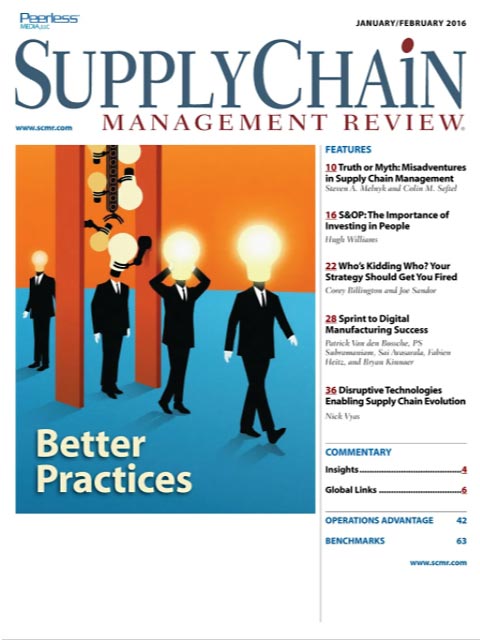Sorry, but your login has failed. Please recheck your login information and resubmit. If your subscription has expired, renew here.
January-February 2016
It’s a new year. Most of us will have new budgets to meet and new expectations for the performance of our supply chains. Many will look to best practices from industry leaders to improve our operations. But, are best practices really the “best” way to go? As you think about 2016, I hope you ask the question: What better practices can I adopt for my supply chain? Browse this issue archive.Need Help? Contact customer service 847-559-7581 More options
If you pay attention to marketing and advertising, you may have seen the series of ads produced by General Electric (GE) that aim to reposition one of the world’s oldest manufacturers of heavy industrial equipment as a digital manufacturer of “software-defined machines and solutions that are connected, responsive and predictive.” The new tagline is GE: The Digital Industrial Company.
Make no mistake about it. Digitization, or digital manufacturing, is drawing a lot of interest from manufacturers, universities, and governments alike. Leading global companies and universities have combined forces in a number of Internet of Things (IoT) consortia, and several governments have recently funded initiatives to encourage the next industrial revolution. But underneath the hype and noise, many manufacturers are
struggling to figure out just what digital manufacturing means to their organizations. They aren’t sure where to start their digital transformation or how to engage their executive team and customers in developing a winning formula.
In fact, we see two predominant approaches to digitization in the marketplace. Some manufacturers “boil the ocean:” They try to track and translate the most recent trends into potential opportunities. Still others are waiting on their IT departments to “connect everything” first before they take action. Neither of these approaches is very effective in successfully digitizing manufacturing operations or products. Instead, we believe there is a third approach, where manufacturers are ready to act and launch digital sprints that can push through the hype and get to real, tangible outcomes without having to predict the future or, even more difficult, to rewire their whole IT infrastructure.
 |
This complete article is available to subscribers
only. Click on Log In Now at the top of this article for full access. Or, Start your PLUS+ subscription for instant access. |
SC
MR
Sorry, but your login has failed. Please recheck your login information and resubmit. If your subscription has expired, renew here.
January-February 2016
It’s a new year. Most of us will have new budgets to meet and new expectations for the performance of our supply chains. Many will look to best practices from industry leaders to improve our operations. But, are… Browse this issue archive. Access your online digital edition.
 |
Download Article PDF |
If you pay attention to marketing and advertising, you may have seen the series of ads produced by General Electric (GE) that aim to reposition one of the world's oldest manufacturers of heavy industrial equipment as a digital manufacturer of “software-defined machines and solutions that are connected, responsive and predictive.” The new tagline is GE: The Digital Industrial Company.
Make no mistake about it. Digitization, or digital manufacturing, is drawing a lot of interest from manufacturers, universities, and governments alike. Leading global companies and universities have combined forces in a number of Internet of Things (IoT) consortia, and several governments have recently funded initiatives to encourage the next industrial revolution. But underneath the hype and noise, many manufacturers are struggling to figure out just what digital manufacturing means to their organizations. They aren't sure where to start their digital transformation or how to engage their executive team and customers in developing a winning formula.
In fact, we see two predominant approaches to digitization in the marketplace. Some manufacturers “boil the ocean:” They try to track and translate the most recent trends into potential opportunities. Still others are waiting on their IT departments to “connect everything” first before they take action. Neither of these approaches is very effective in successfully digitizing manufacturing operations or products. Instead, we believe there is a third approach, where manufacturers are ready to act and launch digital sprints that can push through the hype and get to real, tangible outcomes without having to predict the future or, even more difficult, to rewire their whole IT infrastructure.
 |
SUBSCRIBERS: Click here to download PDF of the full article. |
SC
MR

Latest Supply Chain News
- How S&OP provides the answer to in-demand products
- AI, virtual reality is bringing experiential learning into the modern age
- Humanoid robots’ place in an intralogistics smart robot strategy
- Tips for CIOs to overcome technology talent acquisition troubles
- There is still work to do to achieve supply chain stability
- More News
Latest Podcast

 Explore
Explore
Latest Supply Chain News
- How S&OP provides the answer to in-demand products
- AI, virtual reality is bringing experiential learning into the modern age
- Humanoid robots’ place in an intralogistics smart robot strategy
- Tips for CIOs to overcome technology talent acquisition troubles
- There is still work to do to achieve supply chain stability
- Blooming success: The vital role of S&OE in nurturing global supply chains
- More latest news
Latest Resources

Subscribe

Supply Chain Management Review delivers the best industry content.

Editors’ Picks





